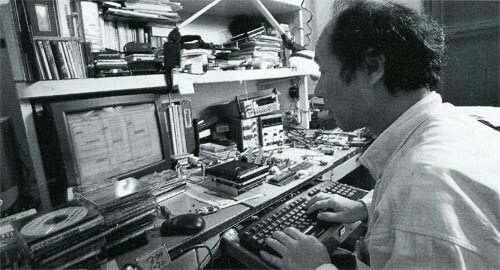"I want to offer a fun audio experience by achieving a wide range sound with detailed information and the best signal-to-noise performance possible."
You joined Marantz in 1973, and you also started working on CD players from a rather early stage?
I wasn't a part of the team that developed the first CD player by Philips, but there were some Marantz engineers involved. Once these engineers came back to japan, we started to develop our own CD pickup system and build our own CD players with parts (drive mechanisms, decoders, demodulators, error correction designs and
DA converters) received from Philips. The error correction circuitry back then was a partly discrete design and all servo related designs were analog. We started developing our own CD player in 1982, and in April 1983, we released the Marantz CD-73, the second Marantz CD player to be put on the market.
Is it true that the Marantz/Philips DA converters back then were 14-bit?
Yes, it was 14-bit, but we used a 4x over-sampling digital filter and noise shaper with the converter. No one back then used digital filters or noise shaping and this was our proprietary technology. These technologies helped us gain signal-to-noise ratio and resolution from the 14-bit DA converter that rivaled that of 16-
bit converters. Back then, it was hard to create a truly 16-bit DA converter, so we made sure the converters were proper at 14-bit and covered the remainder 2-bits with the digital filter and noise shaper circuits.
CD started as a medium without noise, unlike vinyl. Then eventually, manufacturers started to incorporate designs to minimize digital noise and improve sound quality. When did Marantz start working on improving sound quality and noise?
I think we started working on those issues earlier than other manufacturers. We had sound quality improvement circuitry incorporated in the Marantz CD-54 and Marantz CD-84, which were released in 1984. Back then, we used to separate the analog and digital circuit boards, and although we only used one power transformer, there were dedicated windings for the audio and servo circuits.
Did those improvements show up on data?
No, not on data. We started to find these things out by trial and error, whilst we were making prototypes and holding listening tests. Eventually, we found out that we had to incorporate various sound quality improvements; otherwise we really couldn't gain any proper separation and ended up with a smeared sound field. Our largest discovery back then was with the full size die-cast chassis first used in the Marantz CD-94 in 1986, and we ended up using that chassis principle for the next ten years.
From your personal perspective, when did the sound quality of CD players change radically?
Well, the best improvement we achieved was definitely with the Marantz CD-94, so that would be 1986. Due to the solid and rigid chassis design, we were able to gain a good signal-to-noise ratio with a clear and detailed sound.
Having worked primarily on CD players for all these years, what do you think is the secret in making a good sounding CD player?
Well, I'd say back to basics and keep it simple. You can't really improve something that is inferior to start with, well you could, but there is always a limit. Say you have noise issues, you can add a shielding plate or change the grounding scheme, but they won't be fundamental improvements. So, you have to make sure that there is minimal noise to start with. Adding a shielding plate will add to the manufacturing and parts cost and add more wiring. So the secret is in keeping the design simple and using quality parts. I think you 'll understand what I mean when you look inside a Marantz CD player.
Do you take the same approach for Super Audio CD players?
With Super Audio CD players, we take the same approach, but it is more evolved. Super Audio CD players have a lot more highend and dynamic range than CD players, so to get desirable signal-to-noise and separation performance, little tricks just won't cut it. When you deal with dynamic range exceeding 120 dB, a lot of consideration need to go into each individual component, how it behaves and how itis structured. Our HDAM low noise amplifiers have helped immensely in that regard.
Last question. I hear that you 're one of the most enthusiastic audiophiles at Marantz, what kind of sound do you personally like?
Personally, I dislike sounds with a narrow frequency range. I understand that narrow sounds have a distinction and character that is maybe sometimes required, but personally, I always go for sounds with a wide range and high signal-to-noise ratio, with lots of detailed information. The sounds you can get from a disc is different compared to the real thing performed live, so I try to achieve a pleasing sound from the disc. You cant really capture and playback the full dynamics of an orchestra performed live, but I can try to achieve a sound that lets you identify as many instruments as possible. Iid like to offer a pleasing sound with as much information as possible.
Interviewer: Are you not interested in simple music?
No, I am, I like vocals accompanied by piano. In that respect, I want to recreate the mood and atmosphere of the performance, so that the listener grasps every emotional detail of the performer. As a manufacturer, I want to promote the reality of music using our products to achieve a sound with very low noise and the best signal-to-noise performance possible.
